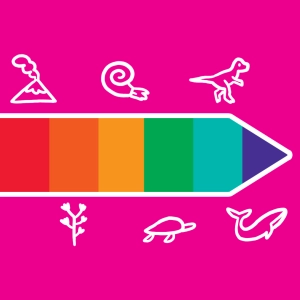 History of Life
History of Life
This animation illustrates the history of the Earth and Life on Earth on a chronological fresco at scale (*). This geological time scale is based on knowledge that is constantly evolving. The International Union of Geological Sciences (IUGS) meets every four years to validate recent discoveries and decide on the denominations and dates of the different subdivisions.
The geological time scale is thus subdivided as follows:
- The "Eons": Hadean, Archaean, Proterozoic and Phanerozoic that define the largest units of time (Order of magnitude: 1 billion years).
- The "Era": Except for the Hadean whose data is too imprecise, eons are divided into 3 or 4 eras (Order of magnitude: 100 million years).
- The "Periods": Each era is divided between several periods (6 for the Paleozoic with an average duration of 40 million years).
Scales and order of magnitude: We have chosen two time scales to represent this very long history of more than 4.5 billion years.
- The first eons of the Earth (Hadean, Archaean and Proterozoic) constitute 90% of the duration. They are all on the same scale: A screen width corresponds to 70 Myr (Million years). For these eons, when the automatic playback mode is activated (click on the "Play" button), the scroll speed is about 5 million years per second. The 2000 years of our calendar would pass in 0.0004 seconds! At this very fast speed, it takes almost 15 minutes to travel these three eons.
- The last eon (Phanerozoic) lasts only 541 Myr. We have deliberately enlarged the scale to 40 Myr for a screen width. In the Phanerozoic, when the automatic playback mode is activated, the scroll speed is about 2 million years per second. On this "slowed down" scale, the 300,000 years that separate us from the first Homo sapiens only constitute 2 millimeters of this 40 meter fresco.
Do you know the animation eduMedia geological clock?
Note: Depending on your bandwidth, it may take several minutes to load the 4.6 billion years of this fresco. It's better than the opposite!
Thanks :
- Fresque "À la rechercher des temps perdus" : http://svt.ac-creteil.fr/?Utiliser-la-fresque-interactive-A-la-recherche-des-temps-perdus
- Ilga Porth, sciences du bois et de la forêt, Université Laval, Québec
- "Planète Terre" par Pierre André Bourque: http://www2.ggl.ulaval.ca/personnel/bourque/intro.pt/planete_terre.html
- Vidéo sur la découverte du groupe fossile de Franceville - Université de Poitiers, Abderrazak El Albani. https://www.youtube.com/watch?v=rjb09EWtt5U
- Wikipedia
